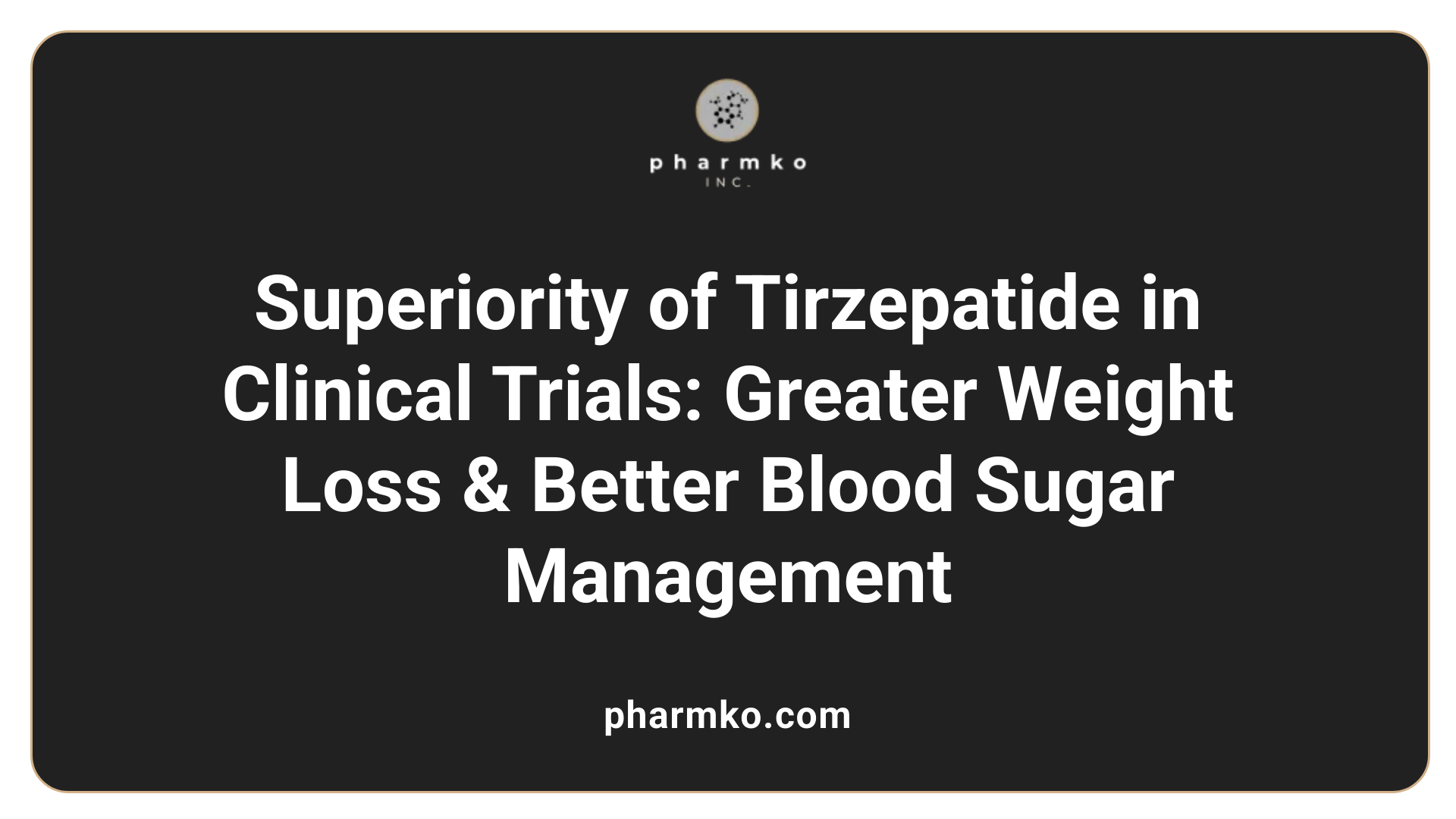Semaglutide vs Tirzepatide results
Understanding the Relative Performance of Semaglutide and Tirzepatide
In recent years, the development and clinical evaluation of GLP-1 receptor agonists and dual GIP/GLP-1 receptor agonists have transformed approaches to managing obesity and type 2 diabetes. Among these, Semaglutide and Tirzepatide have emerged as prominent options. This article explores the comprehensive differences in their clinical efficacy, safety profiles, weight loss outcomes, and the latest research findings from advanced trials to provide an in-depth comparison.
Efficacy in Weight Loss and Glycemic Control in Clinical Trials
 Recent clinical trials highlight the superior effectiveness of Tirzepatide over Semaglutide when it comes to weight loss and blood sugar management.
Recent clinical trials highlight the superior effectiveness of Tirzepatide over Semaglutide when it comes to weight loss and blood sugar management.
In a substantial 72-week study involving 751 participants with obesity or overweight, Tirzepatide achieved an average weight loss of 20.2%, equating to approximately 50.3 pounds (22.8 kg). In comparison, Semaglutide resulted in a 13.7% reduction, or about 33.1 pounds (15.0 kg). This difference underscores Tirzepatide's greater impact on weight reduction.
The trial also demonstrated that more than 80% of patients treated with Tirzepatide lost at least 10% of their body weight, with nearly half (around 50%) losing at least 20%. Additionally, Tirzepatide was more effective in reducing waist circumference, with an average decrease of 18.4 cm versus 13.0 cm with Semaglutide.
In terms of blood sugar control, Tirzepatide showed significant advantages. It lowered HbA1c levels by up to 2.5%, compared to a reduction of about 1-2% with Semaglutide. Patients on Tirzepatide also had a higher probability of achieving weight loss milestones of 5%, 10%, and 15%, with hazard ratios of 1.76, 2.54, and 3.24 respectively, when compared to Semaglutide.
Both drugs have similar gastrointestinal side effects, such as nausea and diarrhea, which are mostly mild to moderate. However, Tirzepatide’s dual mechanism, acting on both GLP-1 and GIP receptors, may enhance its effectiveness for weight loss and glycemic control.
Overall, recent research indicates that Tirzepatide not only promotes more substantial weight loss but also offers better management of blood glucose levels, making it a promising option for individuals with obesity and related metabolic conditions.
Quantifying Weight Loss Benefits and Population Outcomes

How do weight loss results differ between Semaglutide and Tirzepatide?
Tirzepatide has demonstrated superior efficacy in weight reduction compared to Semaglutide, according to recent clinical trials and observational studies. Participants using Tirzepatide experienced on average a 20.2% reduction in body weight over approximately 72 weeks, whereas those on Semaglutide saw about a 13.7% decrease.
Specifically, patients on Tirzepatide lost an average of 22.8 kg (50.3 pounds), compared to 15.0 kg (33.1 pounds) with Semaglutide. These figures highlight Tirzepatide’s stronger impact on weight loss.
In terms of achieving significant weight loss, over 80% of patients on Tirzepatide managed to lose at least 10% of their body weight, and nearly half of them lost 20% or more. Meanwhile, the effectiveness at these milestones is also notably better for Tirzepatide, with higher hazard ratios indicating increased likelihoods of reaching ≥10%, ≥15%, and even ≥20% weight loss milestones.
This difference is also reflected in the percentage of patients reaching various weight loss targets at different intervals. After 12 months, for instance, Tirzepatide users saw a mean reduction of about 15.3%, significantly higher than the 8.3% seen with Semaglutide.
Overall, Tirzepatide not only results in more substantial weight loss but also in a higher proportion of patients achieving meaningful weight reduction, making it a more impactful option for weight management in adults with obesity.
| Aspect | Semaglutide | Tirzepatide | Additional Insights |
|---|---|---|---|
| Average weight loss | ~15–16% | ~20.2% | Based on trial data, indicating greater efficacy of Tirzepatide |
| Mean weight lost | 15 kg | 22.8 kg | Corresponds to roughly 33 pounds vs. 50 pounds |
| Patients losing ≥10% | Less than 80% | Over 80% | Demonstrating higher achievement rates with Tirzepatide |
| Proportion losing ≥20% | Less than 50% | Nearly 50% | Highlights Tirzepatide’s effectiveness in substantial weight loss |
| Timeline for results | 6–12 months | 6–12 months | Both drugs show results within similar periods |
Comparative Safety Profiles and Side Effects

What are the safety profiles and potential side effects of Semaglutide compared to Tirzepatide?
Both Semaglutide and Tirzepatide share similar gastrointestinal side effects, which are the most common adverse events reported with both medications. These include nausea, vomiting, diarrhea, and abdominal discomfort. Generally, these side effects are mild to moderate and tend to resolve over time as the body adjusts to the treatment.
Semaglutide is also associated with a higher risk of gallbladder issues, such as cholelithiasis (gallstones), which may require medical attention. Tirzepatide, being a dual receptor agonist, may cause gastrointestinal discomfort slightly more frequently but has been observed to have fewer severe side effects overall, with a safety profile comparable to semaglutide.
Serious adverse events like pancreatitis and rare thyroid tumors are concerns with both drugs. Both medications carry a black box warning related to thyroid C-cell tumors based on animal studies, and individuals with a history of medullary thyroid cancer should avoid their use.
Despite the similarities, individual responses vary. Tirzepatide might be associated with a slightly better safety profile, especially concerning severe adverse events, but careful patient-specific evaluations are essential.
Overall, the side effect profiles of Semaglutide and Tirzepatide are similar, with gastrointestinal symptoms being the most prevalent. Healthcare providers should weigh these risks alongside the medication’s benefits, considering patient medical history and comorbidities.
Mechanisms of Action and Biological Insights
Understanding GLP-1 receptor agonism
Semaglutide is a medication that specifically targets the glucagon-like peptide-1 (GLP-1) receptor. This gut hormone plays a crucial role in regulating appetite and blood sugar levels. By mimicking GLP-1, semaglutide enhances feelings of fullness, slows stomach emptying, and reduces cravings, leading to decreased food intake and improved blood sugar control.
Dual GIP and GLP-1 receptor activity
Tirzepatide, on the other hand, acts as a dual receptor agonist affecting both GIP (glucose-dependent insulinotropic polypeptide) and GLP-1 receptors. This dual activity means it not only mimics the effects of GLP-1 but also stimulates GIP, another hormone involved in insulin release and fat metabolism.
This combined action amplifies its ability to lower blood sugar and promote weight loss more effectively than single-agonist therapies. Studies indicate that tirzepatide’s dual mechanism may lead to greater reductions in body weight and blood glucose levels, providing an advantage over semaglutide.
Scientific insights into benefits and limitations
Research shows that while semaglutide effectively reduces appetite and slows gastric emptying, tirzepatide’s dual receptor activity offers additional benefits by further enhancing insulin secretion and energy expenditure.
However, tirzepatide’s broader hormonal activity may also cause more gastrointestinal side effects, such as nausea and diarrhea, although these are mostly mild to moderate. Its dual mechanism might also pose challenges relating to long-term safety and optimal dosing, which current studies continue to evaluate.
Overall, both drugs display promising results in weight and blood sugar management, but tirzepatide’s multiple pathways could make it more effective—pending further long-term evidence to fully establish its benefits and limitations.
Real-World Evidence and Clinical Practice Data
Recent large-cohort studies and retrospective data analyses provide valuable insights into how Tirzepatide performs compared to Semaglutide in everyday clinical settings. These studies include thousands of patients treated for obesity and type 2 diabetes, revealing consistent patterns in effectiveness.
A comprehensive cohort study involving over 41,000 US adults with overweight or obesity demonstrated that Tirzepatide significantly outperforms Semaglutide in achieving weight loss of at least 5%, 10%, and 15%. Patients on Tirzepatide were 1.76 times more likely to reach a 5% weight reduction, 2.54 times more likely to achieve at least 10%, and 3.24 times more likely to hit the 15% target. These hazard ratios highlight Tirzepatide's superior effectiveness in real-world treatment.
Retrospective analyses further support these findings, showing higher proportions of patients attaining meaningful weight loss and better glycemic control. Importantly, both drugs exhibit similar rates of gastrointestinal side effects, mainly mild to moderate, suggesting comparable tolerability.
Clinicians note that while both medications are effective, Tirzepatide's dual hormone mechanism may offer additional benefits in routine practice, especially for patients requiring more substantial weight and blood sugar improvements. Nevertheless, choosing the appropriate medication depends on individual medical history, response, and preferences.
Overall, the evidence from large-scale future studies continues to confirm Tirzepatide's lead over Semaglutide in achieving weight loss and improving metabolic health in diverse patient populations.
Cost-Effectiveness and Economic Considerations
When evaluating the economic aspects of obesity treatments, it is essential to consider both therapy costs and their value in improving health outcomes. Recent analyses suggest that Tirzepatide may offer some financial advantages over Semaglutide.
Tirzepatide, administered via subcutaneous injection, has shown to be more cost-effective than Semaglutide, especially when considering long-term benefits. Cost-effectiveness studies utilizing a decision tree model surrounding US healthcare data estimate an incremental cost-effectiveness ratio (ICER) of around $34,212 per quality-adjusted life year (QALY) gained for Tirzepatide. This figure indicates that Tirzepatide provides additional health benefits at a reasonable cost within common willingness-to-pay thresholds.
The economic analysis incorporates factors such as medication costs, the reduction in obesity-related health risks, and the potential for decreased future healthcare expenses due to better weight management and glycemic control. Considering Tirzepatide's superior efficacy in weight loss and its comparable safety profile, the findings suggest that healthcare providers and systems could benefit from including Tirzepatide as a recommended option for obesity treatment.
Overall, these insights imply that Tirzepatide not only enhances clinical outcomes but also offers a more economical approach for health systems aiming to optimize resource utilization while managing obesity-related medical conditions.
| Aspect | Tirzepatide | Semaglutide | Additional Notes |
|---|---|---|---|
| Administration Method | Subcutaneous injection | Subcutaneous injection or oral | Different bioavailability and patient preferences may apply. |
| Cost per Dose | Higher, but offset by greater efficacy | Lower, but potentially less effective | Cost varies depending on insurance coverage and healthcare setting. |
| Impact on Healthcare Utilization | Reduced due to better weight and glucose control | Moderate impact; less pronounced | Longer-term savings likely with Tirzepatide's higher efficacy. |
This evidence supports the inclusion of Tirzepatide as a cost-effective treatment alternative, especially for patients and healthcare systems prioritizing both clinical efficacy and economic sustainability.
Implications for Treatment Decisions and Future Directions

How do Semaglutide and Tirzepatide compare in clinical settings?
Recent studies suggest that tirzepatide outperforms semaglutide in weight loss and blood sugar control. In head-to-head trials like SURMOUNT-5, tirzepatide resulted in an average weight loss of 20.2%, compared to 13.7% with semaglutide, after about 72 weeks.
Patients on tirzepatide also lose more weight—an average of 22.8 kg versus 15.0 kg with semaglutide. The likelihood of achieving significant weight loss (at least 10%, 15%, or 20%) is higher with tirzepatide, supported by greater reductions in waist circumference and faster, more substantial weight reductions over time.
In clinical practice, tirzepatide offers a promising advantage, especially for those seeking maximum weight and glycemic improvements. However, treatment decisions are influenced by individual health profiles, side effect tolerance, cost, accessibility, and patient preferences. Though both medications have favorable safety profiles, gastrointestinal side effects are common.
Ongoing research is vital, as longer-term data are still being collected to confirm these initial promising results and help shape future guidelines.
Long-term outcome data
While current studies show significant short-term benefits, comprehensive data on long-term health outcomes such as cardiovascular risk reduction and sustained weight loss are still needed. Both medications are relatively new, and ongoing observational studies aim to evaluate their impact on major clinical endpoints like myocardial infarction or stroke.
Need for further research
Further research should focus on comparing long-term safety and effectiveness, particularly in diverse populations and different age groups. Prospective studies are also needed to assess quality of life, cost-effectiveness, and adherence patterns. As evidence accumulates, future guidelines will better inform individualized treatment plans, optimizing benefits while minimizing risks.
Summary and Conclusive Insights
Overall effectiveness comparison
Recent clinical trials reveal that Tirzepatide outperforms Semaglutide in promoting weight loss and managing blood sugar levels. In the SURMOUNT-5 trial, patients treated with Tirzepatide experienced an average weight reduction of 20.2%, significantly greater than Semaglutide's 13.7%. Correspondingly, Tirzepatide patients lost an average of 22.8 kg, compared to 15.0 kg with Semaglutide. Additionally, Tirzepatide led to a larger decrease in waist circumference and a higher proportion of patients achieving substantial weight loss milestones.
Key advantages of Tirzepatide
Tirzepatide is a dual receptor agonist targeting both GIP and GLP-1 hormones, which enhances its efficacy in lowering blood sugar and reducing body weight. This dual mechanism is linked to greater improvements in HbA1c and more pronounced weight loss, with some patients losing up to 25% of body weight. The medication's ability to produce larger, faster, and more consistent weight reductions makes it particularly beneficial for those with obesity and type 2 diabetes.
Considerations for clinicians
While Tirzepatide shows promising results, its side effect profile remains similar to Semaglutide, primarily gastrointestinal issues like nausea and vomiting, which are mostly mild or moderate. The choice between these treatments should consider individual patient health history, specific weight loss goals, and tolerability. Cost-effectiveness analyses suggest Tirzepatide might be more favorable over time. Nonetheless, careful monitoring and dose management are essential, especially for patients with a history of thyroid tumors or other contraindications. Both medications require medical oversight to maximize benefits and ensure safety.
Final Considerations and Future Outlook
As research continues to evolve, Tirzepatide consistently demonstrates a trend towards greater efficacy in weight and glycemic management. While safety profiles remain similar, long-term data and cost factors will influence clinical decision-making. Patients and clinicians should weigh individual goals and health considerations, with ongoing studies expected to refine treatment guidelines further. Both medications remain vital tools in the fight against obesity and type 2 diabetes, with Tirzepatide poised to offer even more promising results in the coming years.
References
- Tirzepatide Tops Semaglutide for Weight Loss: SURMOUNT-5
- Semaglutide vs Tirzepatide for Weight Loss in Adults With ...
- Understanding the Differences Between Semaglutide and Tirzepatide
- Semaglutide vs Tirzepatide for Weight Loss in Adults With ... - PubMed
- Tirzepatide as Compared with Semaglutide for the Treatment of ...
- Tirzepatide vs semaglutide: How do they compare? - Drugs.com
- Efficacy of tirzepatide 5, 10 and 15 mg versus semaglutide 2 mg in ...













